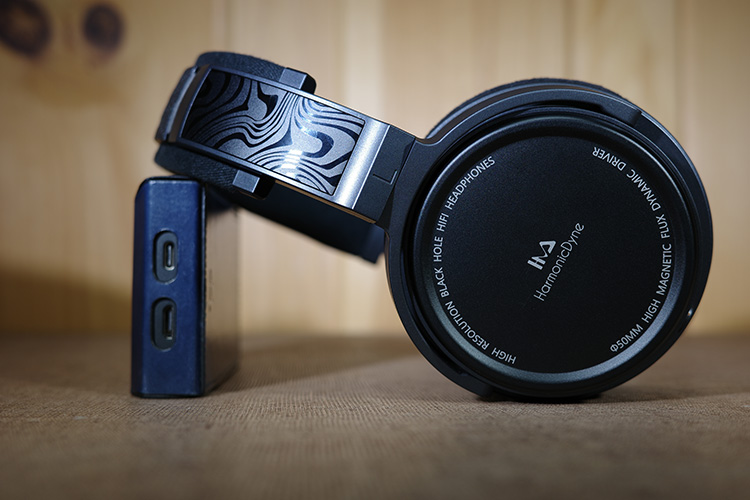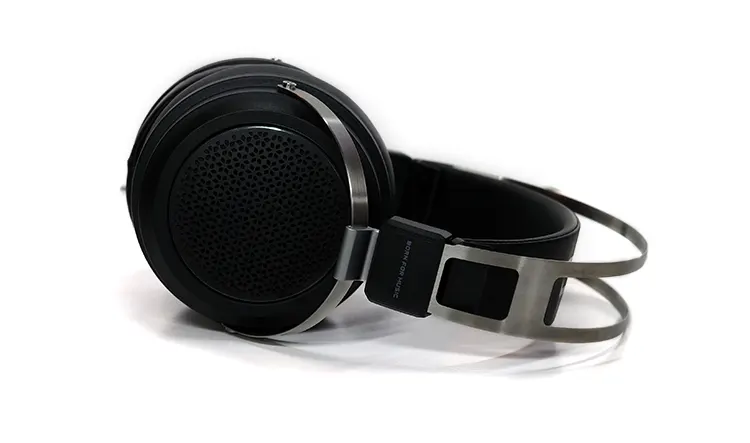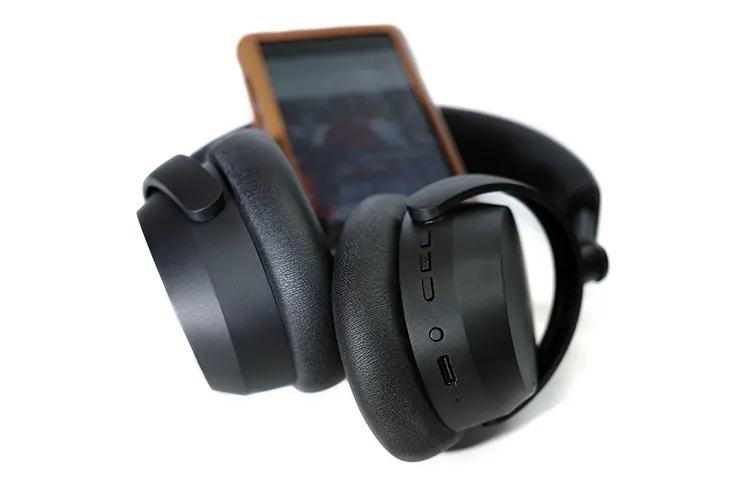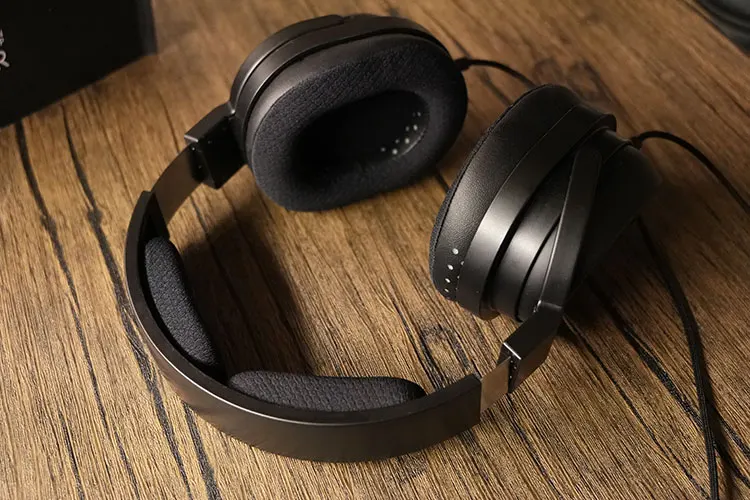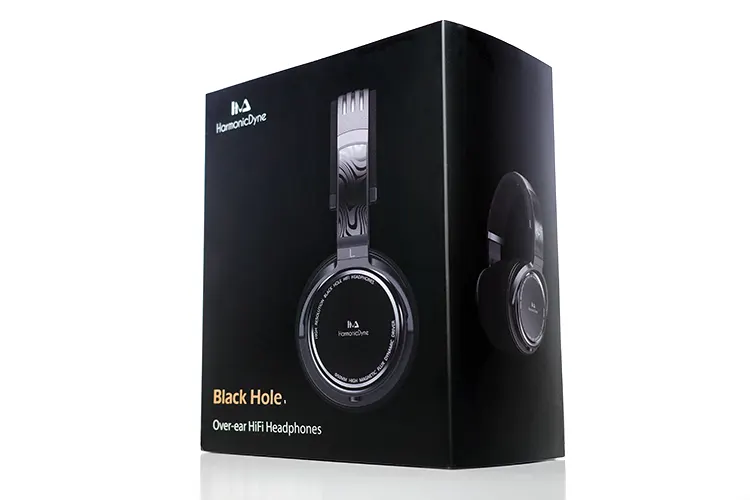Select Comparisons
FiiO Jade Audio JT1
Coming off the JT1, this comparison to the Black Hole makes logical sense, with impeccable timing to boot. Fashioned as the “off-brand” FiiO, the Jade Audio comes across with a bass-oriented tilt like the Black Hole. There is less bleed into the mids, which come across better as well.
Technical
The JT1 employs a 50mm dynamic driver, based around a PEK+PU+aluminum polymer diaphragm purportedly for low distortion characteristics and the brass gasket for quick response.
The JT1 is equipped with high-performance N52 magnets, and a high-tension CCAW voice coil, which when combined with the polymer driver diaphragm achieves a natural and accurate sound. The average 32ohm impedance means the JT1 is also fairly easy to drive.
An OFC copper cable with an inline mic gives the JT1 a slightly warmer presentation.
Design
The JT1 is a closed-back over-ear headphones developed with the help of listeners and influencers according to Vincent from FiiO. Looking at many of the current offerings, the focus quickly became a user-friendly design; which was also cost-efficient.
There is a good amount of plastic to the design, highlighted by an aluminum yoke leading to a non-adjustable stanchion.
Instead of an adjustable stanchion, FiiO uses a two-cabled spring-tensioned setup on the inner headband. Even while wearing a hat, the inner pleather-covered aluminum “sheet” never contacted the two-band stiff aluminum outer band.
The silver/chrome accents carry over to the outer cup surrounds, highlighted by a mesh-patterned backplate, giving the JT1 an elegant, understated look. Vent holes on top of the cup allow for the release of pressure when putting the Jade on, which is good since the ear pads compress readily.
Those cups are easily detachable, using the “old school” slot behind the pad mounting system. This means you could easily change pads to another if you desire, instead of the plastic button-type earpad you might usually find at this level.
At 353 grams, approximately, the JT1 feels light and maneuverable, without feeling cheap. Quality materials help with the feel and look, aided by the lighter nature of the unit.
Performance
An elevated bottom end drops into the mids, smoothly until about 650hz, making bass the highlight, running deep into the sub-bass (unlike the BH), but cooling off at that break.
Elevated mids carry the signature forward with a peak at roughly 6kHz, dropping off again and eventually quite steeply at roughly 14kHz.
As a result, the sub-bass is defined as a bit boomy, but not as much as the Black Hole.
The dip allows very little bleed into the midsection, where the building of notes carries slightly forward, but not in a punchy way, but rather smoothly. Treble notes carry energy, but the rounding of notes gives the signature a lack of true sparkle.
A wide soundstage (unlike the BH’s narrower set) helps to space notes across the setting but with less depth and height. Out-of-head experiences do occur as a result but seem a bit flattened when only looking at this aspect.
The Black Hole carries better height and comparable depth to the soundstage, making this choice come down to other aspects rather than sound since they are somewhat similar.
Sennheiser Accentum Wireless
The Sennheiser Accentum Wireless lies just above the Black Hole but with a potentially similar demographic looking at the two. Since the Accentum can be used wired as well, this makes for an interesting and pertinent comparison.
Technical
The Sennheiser Accentum Wireless is a set of closed-back wireless, (Bluetooth), headphones with additional hybrid ANC capability and Smart Control app integration.
The Accentum uses a 37mm dynamic driver and supports USB-C audio for wired connectivity and a BT 5.2-capable internal chipset for wireless connectivity.
It is capable of receiving and decoding from SBC and AAC up to aptX, and aptX HD codecs. However, there is no LDAC or aptX Adaptive capability currently.
The hybrid ANC technology is either on or in transparency mode through Sennheiser’s Smart Control app (or a double press of the power/pairing button). There is no middle ground.
But, Sennheiser has a history of good ANC quality in their wireless options so it should be worthy of the moniker. ANC will be discussed below but suffice to say it is an interesting take on the inclusion of this technology.
No cable jack is included, only a USB-C charging port so the Accentum is a wireless headphone first and foremost though you can use the USB-C port for digital lossless audio with good results.
Design
The Accentum follows Sennheiser’s subtle and understated look in most of their Bluetooth models. Smaller in size, the unit only folds flat and the cups do not fold up to make the unit more portable.
The cup size is medium-small, and those with larger ears will most likely suffer from the pads lying on their ears. Stuffed with memory foam, the pads are comfortable for moderate use but have no waterproof rating.
The Accentum is made mostly of plastic and the headband carries over in one piece with a memory foam insert underneath for head relief. While the fit and materials are on the budget side, they do follow the market segment.
That padding only goes halfway down the band in a somewhat odd shape while supporting the top of your head. Those with larger heads may find the pad/hard plastic interface could hinder comfort.
Vent slots sit on top of each cup, while two microphone holes sit on the face and side of the right cup; closer to where they are needed.
The tactile buttons control all functions on the right cup, with no swipe gesturing. Those buttons work well, and it becomes intuitive after a short period of use. There is a button for ANC, which is controlled via the app or double press of the power/pairing button.
Performance
Using a USB-C to USB-C cable I compared the Black Hole and Accentum on a wired to wired only basis. I was able to easily connect the Accentum to my MacBook Pro using the cable. Playing Tidal, the sound was reminiscent of a nicely tuned wired headphone in the same market level.
I was impressed with the added richness to the sound signature over BT and could reach loud enough volume levels to make for a satisfying experience. With a much more even signature, with fewer peaks and valleys, the Accentum sounded more neutral than the BH, while also having a more vibrant signature.
Adding richness to the sound signature, the note weight became a bit more prevalent, but with good detail as well. The separation of notes allowed detail retrieval to become more focused while raising the level of clarity. The soundstage filled the space, but with more definition, which followed suit when adding a cable.
Anytime you add a cable, the sound should be better over BT, since you are using an external DAC. As good as BT has gotten, it still falls behind cable options for the most part.
Running wired, the bass was still a bit too boomy, presiding over the show. This fell in line with the Black Hole but with less of a booming character. Of note is that when tethered to a source, there is an additional benefit of the battery charging while you are listening. This is a definite positive.
Just make sure if you run an MBP (or your PC) to keep a USB-C to USB-C cable handy for the additional quality if you would like.
Moondrop Joker
The Moondrop Joker is a closed-back 50mm dynamic driver, designed for monitoring. Set with a very similar price, the two go about their business quite differently.
Technical
Featuring a sleek design, the Joker headphones incorporate a 50mm dynamic driver. The driver unit is designed using the contemporary Finite Element Analysis (FEA) technology approach.
Inside the driver unit houses N52 Neodymium magnets and a lightweight CCAW coil. The driver also employs a flexible damping suspension ring around the membrane and in the middle, fusing a partially rigid alloy-coated dome composite diaphragm.
Additional damping allows for a more precise sound, paired with the angled driver units inside the cups. Oriented towards maximum detail and clarity, the Joker comes at this level from a different perspective.
Design
The Joker offers premium features regardless of its positioning, including interchangeable cables and ear-pads that are equipped with a convenient quick-release lock mechanism (as opposed to the traditional groove on the BH).
Subtle artwork does help to add some fun factor to the design, breaking the normally traditional look up a bit.
The headband on the Joker is wide and allows for easy adjustment. While there may not be markings on the extendable parts, it is still easy to gauge the number of steps pulled out (like the BH).
The build quality is satisfactory and the aesthetics reminiscent of the Sony MDR-R10 is awesome (which was a marker set by Moondrop in the design).
Additionally, the package includes a piece of sandpaper, which enables users to reveal the brass beneath the paint, reminiscent of the worn-out black-paint Leica cameras. This is quite a unique move for personalization, and you can try sanding off all the paint and polishing the brass surface, or laser engraving the ear cups.
Performance
The Joker exhibits a W-shaped response with plenty of bass energy and dipped mids. Compared to quite a few of the studio cans the Joker has a larger driver that seemingly allows the bass to deliver a stronger punch.
There is more warmth in the tuning than in average studio monitors. That said, it comes across as more detail-oriented, and slightly more neutral than the Black Hole.
Due to the higher impedance, the Joker sounds quite consistent across different sources, but a powerful source is preferred, or the vocals may sound compressed and hollow.
Our Verdict
The HarmonicDyne Black Hole follows on the successful heels of the Zeus Elite and Athena, at an entry-level point.
Continuing the affordable bracket, the Black Hole comes at you with thumping, but uncontrolled bass. While the quantity is immense, the bleed into the otherwise good lower mids detracts from the overall.
Fit is good, and along with the “looks” department makes for a solid entry point for those looking at something different from their usual fare. I found that long sessions were somewhat tedious due to the lack of padding and the rectangular opening on the inside of the pads.
Nonetheless, the HarmonicDyne Black Hole will appeal to those who favor a gripping low-end, that allows them to move along with the music. For those who like a good low-end grunt, and a smoother character to the signature, the Black Hole just might work.
HarmonicDyne Black Hole Technical Specifications
- Driver Unit: 50mm Dynamic Driver
- Acoustic Structure: Semi-open
- Input Impedance: 32Ω @1KHz
- Frequency Response: 10-40KHz (free field)
- Sensitivity: 110dB/Vrms @1KHz
- Harmonic Distortion: ≤0.15% @1KHz 100dB SPL
- Audio Cable: 5 meters Oxygen-Free Copper Cable
- Cable Connectors: 5mm
- Ear Cushions: Special Velvet
- Product Dimensions: 210x175x105 (mm)
- Product Weight: About 305g

